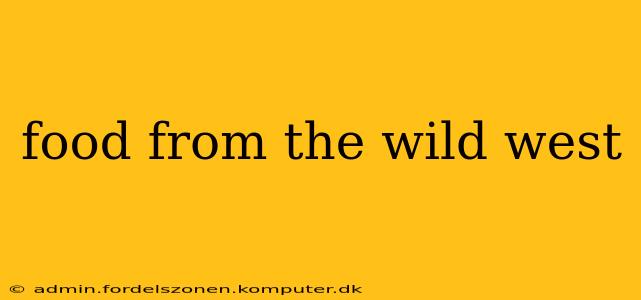The Wild West conjures images of cowboys, cattle drives, and dusty saloons. But beyond the romanticized narratives lies a fascinating culinary history, shaped by necessity, ingenuity, and the diverse cultures that converged in this rugged landscape. This exploration dives into the foods that fueled the pioneers, cowboys, and settlers of the American West, revealing a surprisingly rich and varied culinary tradition.
What Did Cowboys Eat on the Trail?
This is a frequently asked question, and the answer isn't as simple as beans and jerky (though those were staples!). The cowboy diet varied significantly depending on the season, the length of the drive, and the rancher's resources. While jerky – dried beef – provided a long-lasting protein source, cowboys also relied heavily on beans, often pinto beans, for their nutritional value and ease of preparation. Hardtack, a long-lasting but incredibly tough biscuit, was another common staple, often softened in coffee or soup. Coffee itself was a crucial element, providing caffeine and warmth on chilly mornings. When available, fresh vegetables like onions and potatoes were added to the menu, offering a welcome change from the typically monotonous fare. Meat, when possible, included bacon, and occasionally, fresh beef from cattle on the drive.
What Were Some Common Foods in Wild West Towns?
Wild West towns, though often depicted as lawless, were hubs of culinary activity. Saloons served as vital social centers, and their food offerings reflected the diverse populations they served. Hearty, filling meals were essential for working men, and stews, chili, and roasted meats were commonplace. Bread, often baked in wood-fired ovens, was a staple, accompanied by simple side dishes like beans or potatoes. These towns also saw the beginnings of diverse culinary influences, as immigrants from across the globe brought their unique recipes and ingredients.
What Kinds of Food Did Pioneers Eat?
The food consumed by pioneers reflected their resourcefulness and the challenges of frontier life. Preservation techniques were paramount, with methods like pickling, salting, and drying ensuring food lasted through harsh winters. Game, such as deer, rabbit, and wild fowl, supplemented the diet, while foraging for wild plants and berries added crucial nutrients. Cornmeal became a cornerstone of pioneer cooking, used in breads, mush, and other dishes. Fruit cakes, often dense and heavy, also served as a valuable source of energy and nutrition.
What about desserts in the Wild West?
While sustenance was paramount, desserts did find their place in Wild West life. Simple cobblers, pies (using readily available fruits), and cookies provided a sweet end to a meal, or a morale booster on a long journey. The availability of ingredients, of course, heavily influenced what kinds of desserts could be made. Honey was often used as a sweetener, reflecting the relative scarcity of refined sugar.
What role did indigenous foods play in Wild West cuisine?
The contributions of indigenous peoples to Wild West cuisine are often overlooked. However, their knowledge of the land and its resources played a significant role in the survival and sustenance of settlers and pioneers. Native American cooking techniques, ingredients like wild rice, and the use of native plants and herbs enriched the culinary landscape of the West.
How did the Wild West's food evolve over time?
As the West became more settled, the availability of ingredients and the influence of diverse cultures led to a gradual evolution in foodways. The introduction of railroads facilitated the transport of goods, making a wider variety of foods accessible. This led to a less austere diet, with a greater emphasis on diversity and the incorporation of new culinary traditions.
The food of the Wild West wasn't just about survival; it was a testament to the resourcefulness and adaptability of the people who shaped this iconic period of American history. From the simple fare of the trail to the diverse offerings of boomtowns, the culinary landscape of the Wild West offers a captivating glimpse into a unique era.
